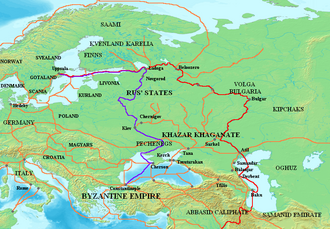
Back Warangiërs AF فارانجيون Arabic Varyaqlar AZ Варагі BE Варагі BE-X-OLD Варяги Bulgarian Vareged BR Varjazi BS Varegs Catalan Varjagové Czech

The Varangians (/vəˈrændʒiənz/; Old Norse: Væringjar; Medieval Greek: Βάραγγοι, Várangoi;[1][2] Old East Slavic: варяже, varyazhe or варязи, varyazi) were Viking[3] conquerors, traders and settlers, mostly from present-day Sweden.[4][5][6] The Varangians settled in the territories of present-day Belarus, Russia and Ukraine from the 8th and 9th centuries, and established the state of Kievan Rus' as well as the principalities of Polotsk and Turov. They also formed the Byzantine Varangian Guard, which later also included Anglo-Saxons.[7][8]
According to the 12th-century Primary Chronicle, a group of Varangians known as the Rus'[9] settled in Novgorod in 862 under the leadership of Rurik. Before Rurik, the Rus' might have ruled an earlier hypothetical polity known as the Rus' Khaganate. Rurik's relative Oleg conquered Kiev in 882 and established the state of Kievan Rus', which was later ruled by Rurik's descendants.[10][11]
Engaging in trade, piracy, and mercenary service, Varangians roamed the river systems and portages of Gardariki, as the areas north of the Black Sea were known in the Norse sagas. They controlled the Volga trade route (between the Varangians and the Muslims), connecting the Baltic to the Caspian Sea and the Dnieper and Dniester trade route (between Varangians and the Greeks) leading to the Black Sea and Constantinople.[12] Those were the main important trade links at that time, connecting Medieval Europe with Abbasid Caliphates and the Byzantine Empire.[13] Most of the silver coinage in the West came from the East via those routes.
Attracted by the riches of Constantinople, the Varangian Rus' began the Rus'-Byzantine Wars, some of which resulted in advantageous trade treaties. At least from the early 10th century, many Varangians served as mercenaries in the Byzantine Army, constituting the elite Varangian Guard (the bodyguards of Byzantine emperors). Eventually most of them, in Byzantium and in Eastern Europe, were converted from Norse paganism to Orthodox Christianity, culminating in the Christianization of Kievan Rus' in 988. Coinciding with the general decline of the Viking Age, the influx of Scandinavians to Rus' stopped and Varangians were gradually assimilated by East Slavs by the late 11th century.
- ^ "Varangian Archived 12 June 2018 at the Wayback Machine," Online Etymology Dictionary
- ^ "Varangian". TheFreeDictionary.com. Archived from the original on 11 July 2018. Retrieved 30 September 2015.
- ^ Ildar Kh. Garipzanov, The Annals of St. Bertin (839) and Chacanus of the Rhos Archived 28 September 2011 at the Wayback Machine. Ruthenica 5 (2006) 3–8 sides with the old theory.
- ^ "væringer". Store norske leksikon. Archived from the original on 12 June 2018. Retrieved 30 September 2015.
- ^ Little, Becky. "When Viking Kings and Queens Ruled Medieval Russia". HISTORY. Archived from the original on 6 April 2022. Retrieved 4 April 2022.
- ^ "Rus | people | Britannica". www.britannica.com. Archived from the original on 24 March 2022. Retrieved 4 April 2022.
- ^ Milner-Gulland, R. R. (1989). Atlas of Russia and the Soviet Union. Phaidon. p. 36. ISBN 0-7148-2549-2. Archived from the original on 4 April 2023. Retrieved 30 March 2023.
- ^ Schultze, Sydney (2000). Culture and Customs of Russia. Greenwood Publishing Group. p. 5. ISBN 0-313-31101-3. Archived from the original on 4 April 2023. Retrieved 31 March 2023.
- ^ "Пушкинский Дом (ИРЛИ РАН) > Новости". Archived from the original on 16 March 2015. Retrieved 30 September 2015.
- ^ Duczko, Wladyslaw (2004). Viking Rus. Brill Publishers. pp. 10–11. ISBN 90-04-13874-9. Archived from the original on 14 April 2023. Retrieved 1 December 2009.
- ^ "Rurik Dynasty". Encyclopædia Britannica. Archived from the original on 27 March 2015. Retrieved 30 September 2015.
- ^ Stephen Turnbull, The Walls of Constantinople, AD 324–1453, Osprey Publishing, ISBN 1-84176-759-X.
- ^ Schofield, Tracey Ann Vikings Archived 14 April 2023 at the Wayback Machine, Lorenz Educational Press, p. 7, ISBN 978-1-5731-0356-5